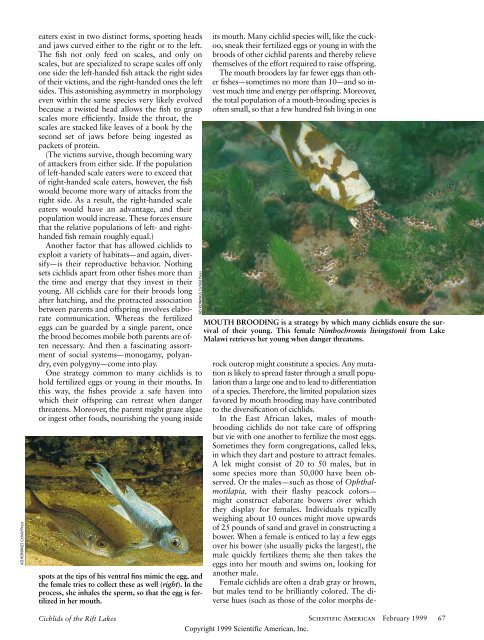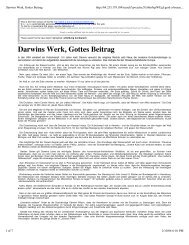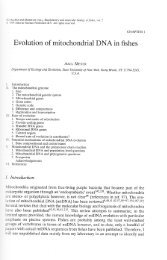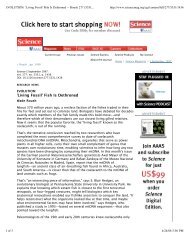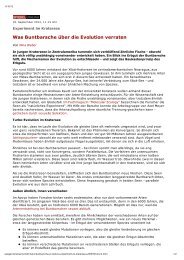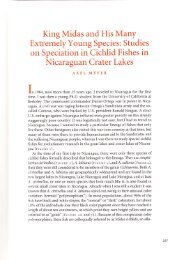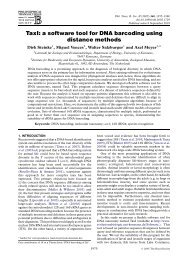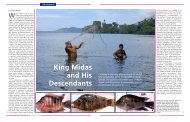Cichlids of the Rift Lakes - Scientific American Digital
Cichlids of the Rift Lakes - Scientific American Digital
Cichlids of the Rift Lakes - Scientific American Digital
Create successful ePaper yourself
Turn your PDF publications into a flip-book with our unique Google optimized e-Paper software.
AD KONINGS Cichlid Press<br />
eaters exist in two distinct forms, sporting heads<br />
and jaws curved ei<strong>the</strong>r to <strong>the</strong> right or to <strong>the</strong> left.<br />
The fish not only feed on scales, and only on<br />
scales, but are specialized to scrape scales <strong>of</strong>f only<br />
one side: <strong>the</strong> left-handed fish attack <strong>the</strong> right sides<br />
<strong>of</strong> <strong>the</strong>ir victims, and <strong>the</strong> right-handed ones <strong>the</strong> left<br />
sides. This astonishing asymmetry in morphology<br />
even within <strong>the</strong> same species very likely evolved<br />
because a twisted head allows <strong>the</strong> fish to grasp<br />
scales more efficiently. Inside <strong>the</strong> throat, <strong>the</strong><br />
scales are stacked like leaves <strong>of</strong> a book by <strong>the</strong><br />
second set <strong>of</strong> jaws before being ingested as<br />
packets <strong>of</strong> protein.<br />
(The victims survive, though becoming wary<br />
<strong>of</strong> attackers from ei<strong>the</strong>r side. If <strong>the</strong> population<br />
<strong>of</strong> left-handed scale eaters were to exceed that<br />
<strong>of</strong> right-handed scale eaters, however, <strong>the</strong> fish<br />
would become more wary <strong>of</strong> attacks from <strong>the</strong><br />
right side. As a result, <strong>the</strong> right-handed scale<br />
eaters would have an advantage, and <strong>the</strong>ir<br />
population would increase. These forces ensure<br />
that <strong>the</strong> relative populations <strong>of</strong> left- and righthanded<br />
fish remain roughly equal.)<br />
Ano<strong>the</strong>r factor that has allowed cichlids to<br />
exploit a variety <strong>of</strong> habitats—and again, diversify—is<br />
<strong>the</strong>ir reproductive behavior. Nothing<br />
sets cichlids apart from o<strong>the</strong>r fishes more than<br />
<strong>the</strong> time and energy that <strong>the</strong>y invest in <strong>the</strong>ir<br />
young. All cichlids care for <strong>the</strong>ir broods long<br />
after hatching, and <strong>the</strong> protracted association<br />
between parents and <strong>of</strong>fspring involves elaborate<br />
communication. Whereas <strong>the</strong> fertilized<br />
eggs can be guarded by a single parent, once<br />
<strong>the</strong> brood becomes mobile both parents are <strong>of</strong>ten<br />
necessary. And <strong>the</strong>n a fascinating assortment<br />
<strong>of</strong> social systems—monogamy, polyandry,<br />
even polygyny—come into play.<br />
One strategy common to many cichlids is to<br />
hold fertilized eggs or young in <strong>the</strong>ir mouths. In<br />
this way, <strong>the</strong> fishes provide a safe haven into<br />
which <strong>the</strong>ir <strong>of</strong>fspring can retreat when danger<br />
threatens. Moreover, <strong>the</strong> parent might graze algae<br />
or ingest o<strong>the</strong>r foods, nourishing <strong>the</strong> young inside<br />
spots at <strong>the</strong> tips <strong>of</strong> his ventral fins mimic <strong>the</strong> egg, and<br />
<strong>the</strong> female tries to collect <strong>the</strong>se as well (right). In <strong>the</strong><br />
process, she inhales <strong>the</strong> sperm, so that <strong>the</strong> egg is fertilized<br />
in her mouth.<br />
AD KONINGS Cichlid Press<br />
its mouth. Many cichlid species will, like <strong>the</strong> cuckoo,<br />
sneak <strong>the</strong>ir fertilized eggs or young in with <strong>the</strong><br />
broods <strong>of</strong> o<strong>the</strong>r cichlid parents and <strong>the</strong>reby relieve<br />
<strong>the</strong>mselves <strong>of</strong> <strong>the</strong> effort required to raise <strong>of</strong>fspring.<br />
The mouth brooders lay far fewer eggs than o<strong>the</strong>r<br />
fishes—sometimes no more than 10—and so invest<br />
much time and energy per <strong>of</strong>fspring. Moreover,<br />
<strong>the</strong> total population <strong>of</strong> a mouth-brooding species is<br />
<strong>of</strong>ten small, so that a few hundred fish living in one<br />
MOUTH BROODING is a strategy by which many cichlids ensure <strong>the</strong> survival<br />
<strong>of</strong> <strong>the</strong>ir young. This female Nimbochromis livingstonii from Lake<br />
Malawi retrieves her young when danger threatens.<br />
rock outcrop might constitute a species. Any mutation<br />
is likely to spread faster through a small population<br />
than a large one and to lead to differentiation<br />
<strong>of</strong> a species. Therefore, <strong>the</strong> limited population sizes<br />
favored by mouth brooding may have contributed<br />
to <strong>the</strong> diversification <strong>of</strong> cichlids.<br />
In <strong>the</strong> East African lakes, males <strong>of</strong> mouthbrooding<br />
cichlids do not take care <strong>of</strong> <strong>of</strong>fspring<br />
but vie with one ano<strong>the</strong>r to fertilize <strong>the</strong> most eggs.<br />
Sometimes <strong>the</strong>y form congregations, called leks,<br />
in which <strong>the</strong>y dart and posture to attract females.<br />
A lek might consist <strong>of</strong> 20 to 50 males, but in<br />
some species more than 50,000 have been observed.<br />
Or <strong>the</strong> males—such as those <strong>of</strong> Ophthalmotilapia,<br />
with <strong>the</strong>ir flashy peacock colors—<br />
might construct elaborate bowers over which<br />
<strong>the</strong>y display for females. Individuals typically<br />
weighing about 10 ounces might move upwards<br />
<strong>of</strong> 25 pounds <strong>of</strong> sand and gravel in constructing a<br />
bower. When a female is enticed to lay a few eggs<br />
over his bower (she usually picks <strong>the</strong> largest), <strong>the</strong><br />
male quickly fertilizes <strong>the</strong>m; she <strong>the</strong>n takes <strong>the</strong><br />
eggs into her mouth and swims on, looking for<br />
ano<strong>the</strong>r male.<br />
Female cichlids are <strong>of</strong>ten a drab gray or brown,<br />
but males tend to be brilliantly colored. The diverse<br />
hues (such as those <strong>of</strong> <strong>the</strong> color morphs de-<br />
<strong>Cichlids</strong> <strong>of</strong> <strong>the</strong> <strong>Rift</strong> <strong>Lakes</strong> <strong>Scientific</strong> <strong>American</strong> February 1999 67<br />
Copyright 1999 <strong>Scientific</strong> <strong>American</strong>, Inc.


